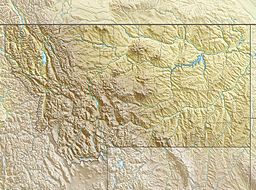Horseshoe Hills facts for kids
Quick facts for kids Horseshoe Hills |
|
|---|---|
| Highest point | |
| Elevation | 6,673 ft (2,034 m) |
| Geography | |
| Country | United States |
| State | Montana |
The Horseshoe Hills are a group of hills in Montana, USA. They are shaped like a crescent moon or a horseshoe. These hills are found north of Manhattan, Montana. They are located in Gallatin County, Montana.
The Horseshoe Hills reach a height of about 6,673 feet (2,034 meters). They sit between two larger mountain ranges. To the south are the Big Belt Mountains. To the north is the Bridger Range.
Contents
Exploring the Horseshoe Hills
The Horseshoe Hills are a unique part of Montana's landscape. They offer interesting views and a special environment. These hills are not as tall as mountains, but they still stand out.
Where are the Horseshoe Hills?
The hills are located in the southwestern part of Montana. They are part of Gallatin County. This area is known for its wide-open spaces. The town of Manhattan is just south of the hills.
The northern edge of the hills is marked by Sixteen Mile Creek. This creek is important because it flows into the Missouri River. The Missouri River is one of the longest rivers in North America.
How the Hills Were Formed
The Horseshoe Hills were formed over millions of years. They are made up of different types of rock. These rocks were pushed up and shaped by natural forces. This process created the rolling hills we see today.
The hills are part of a larger geological area. This area includes many other mountain ranges. These ranges were formed by similar geological events.
Climate and Environment
The Horseshoe Hills have a very dry climate. This is because they are in a "rain shadow." A rain shadow happens when mountains block rain clouds. The clouds drop their rain on one side of the mountains. The other side, where the Horseshoe Hills are, stays dry.
The Rain Shadow Effect
The Horseshoe Hills are in the rain shadow of several mountains. These include the Boulder, Elkhorn, and Bull Mountains to the west. This means the hills get very little rain. They receive only about 10 to 12 inches (25 to 30 centimeters) of rain each year.
The southern and southeastern parts of the hills are even drier. They are in the rain shadow of the hills themselves. This makes these areas especially arid.
Plants of the Horseshoe Hills
Because it is so dry, special plants grow here. These plants can survive with very little water. You can find different types of cactus.
- Missouri foxtail cacti: These small cacti have a unique shape. They are well-adapted to dry conditions.
- Plains prickly pear cacti: These cacti have flat, paddle-shaped pads. They often have bright flowers.
- Yucca: Yucca plants have long, spiky leaves. They can store water in their thick roots.
These plants are important for the local wildlife. They provide food and shelter.
Animals of the Horseshoe Hills
The dry environment is also home to specific animals. One notable animal is the prairie rattlesnake. These snakes are venomous, so it's important to be careful if you see one. They blend in well with the dry landscape.
Other animals that might live here include:
- Deer
- Coyotes
- Various birds of prey, like hawks and eagles
- Small rodents that can survive in dry areas
These animals have adapted to the dry conditions. They find food and water in this unique environment.
Land Ownership and Access
Much of the Horseshoe Hills area is private property. This means it belongs to individuals or companies. However, there are also some public lands.
Public Lands in the Hills
Some parts of the Horseshoe Hills are managed by the government. These include:
- State land: Managed by the state of Montana.
- Bureau of Land Management (BLM) land: Managed by the U.S. federal government. This land is often used for recreation and grazing.
- National Forest land: Managed by the U.S. Forest Service. These areas are usually open for public use.
These public lands offer opportunities for outdoor activities. People can hike, explore, or observe wildlife. It is important to know which areas are public and which are private. Always respect private property signs.



